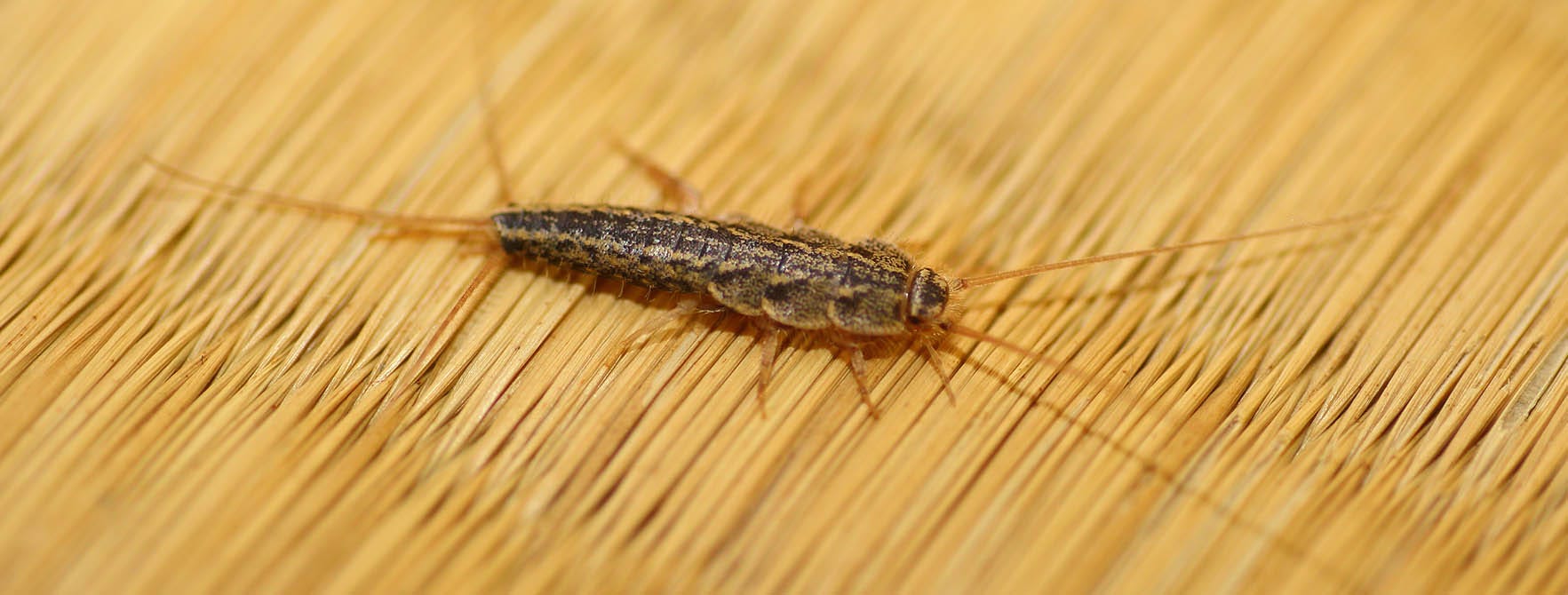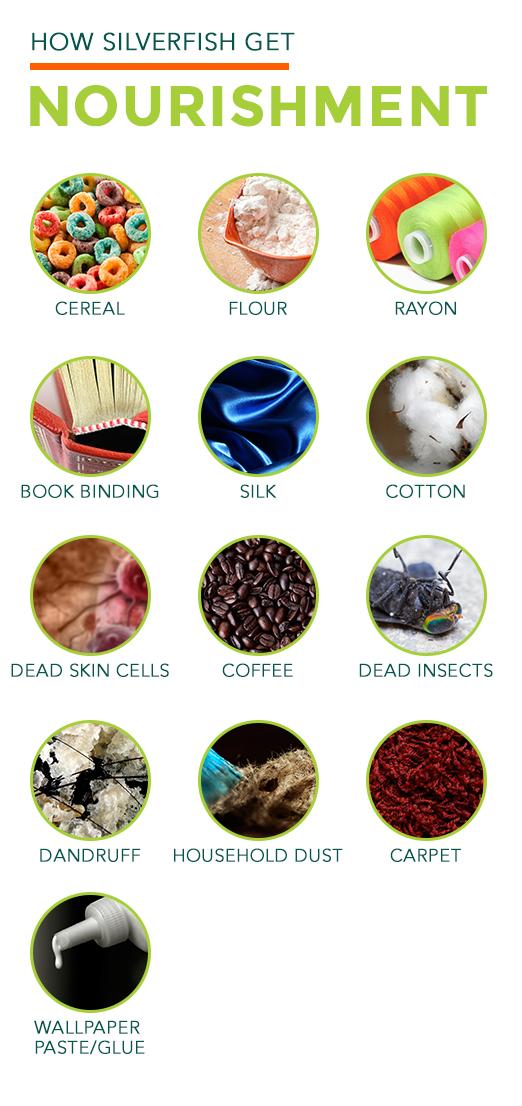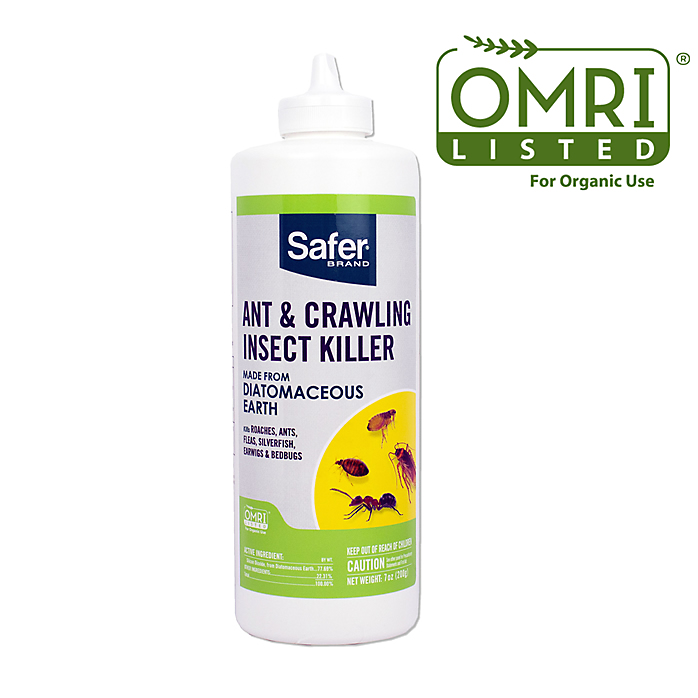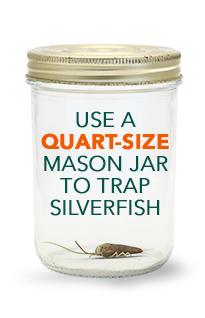

Silverfish are difficult to exterminate because they move around at night. Most of the time, homeowners don’t know they are in the home until they notice the damage causing by silverfish feeding.
Instead of choosing chemical controls that contain toxic and harmful substances, you can choose controls to eliminate the silverfish pests in your home.
You can make homemade traps and use products found in the home to help control silverfish. If these do not work, you can buy poison-free products from Safer® Brand to control silverfish and other insect pests in your home.
Using a product such as Safer® Brand Ant and Crawling Insect Killer uses the power of diatomaceous earth as an effective method of controlling silverfish. Insects cannot develop a resistance to diatomaceous earth because it is a mechanical killer. However, insects can build up immunity to synthetic chemicals.
So…What’s a Silverfish?
What are silverfish? They are silvery, but they are definitely not fish. They are insects that have silvery, overlapping scales that tend to easily rub off. They come inside searching for food and find any minute food particle left lying around your home. Silverfish don’t stink or bring germs inside your home.
Silverfish may come into your home when you bring boxes inside that were stored in an infested area. They may also come into your home in search of moisture during hot, dry summers. Silverfish can enter your home through cracks or holes.
You can easily recognize them by their silvery-blue color, tail-like appendages, and two-long antennae.
Silverfish are gray to silver in color, and adults are about ¼- to ½-inch in length. These soft-bodied insects are flat with long, carrot-shaped bodies. The insects’ five long appendages are located on the tips of their abdomen.
They do not have wings, so they cannot fly, but they are very fast as they dart about searching for food or hiding places. Silverfish are often mistaken for cockroaches because they are seen scurrying away quickly at night when the lights come on.
You can identify silverfish by the following characteristics:
Stopping for a short time before darting off
Inability to climb smooth surfaces (like sinks or tubs)
Active at night (nocturnal)
You may think silverfish are no big deal, until you’ve seen the damage an infestation can cause in your home. They find many belongings in your home tasty, like books, wallpaper and shirts. They may eat pages from your books for dinner and your favorite shirt for dessert!
What Damage Do Silverfish Cause?

You may be wondering what harm these insects cause, or if silverfish are poisonous. The answer is no. Silverfish are annoying, but they do not bite or carry disease.
Silverfish get the nourishment they need from foods and other products that are high in starch, protein or sugar content. They eat a variety of substances.
Nuisance pests cause damage to your home or belongings. Silverfish cause damage by feeding on items in your home, such as:
- Food stored in pantries
- Books
- Papers
- Wallpaper
- Clothing
- Linens
- Unopened food packages (sometimes)
Silverfish can also go a long time between feedings, so they can live for months without food. They may also feed on very young termites if they find a nest in or nearby your home.
As silverfish feed, they leave behind small holes and often a yellowish-colored stain due to the fungus related to feeding damage.
The damage caused by silverfish feeding and the small, pepper-like feces they leave behind are signs of an infestation.
Reproduction Patterns of Silverfish
Silverfish do a little dance before mating. The two insects touch antennae before one chases the other. Together, they spin crazily back and forth until they are ready to mate. This mating dance is done only once during a silverfish’s lifetime, so it is rare for the female to lay more than one batch of eggs during her entire life.
Female silverfish lay eggs individually or in clusters ranging from 2 to 50, depositing them in small cracks. The eggs are microscopic, making them difficult to see with the human eye. Silverfish eggs can take up to 2 months to hatch. The young nymphs somewhat resemble the adults and are ready to feed upon hatching.
After four to six weeks, the young develop into adults, molting up to 60 times throughout the development process. They also continually molt throughout adulthood. A silverfish’s lifespan ranges from two to eight years.
Silverfish's Habitat
Although silverfish usually make their home outdoors under rocks, bird nests and other hidden spots, they are also readily found in homes.
 They prefer dark places with high moisture and temperatures between 70° and 80° Fahrenheit, such as basements, bathrooms, laundry rooms and kitchens. Homeowners may find them in their tubs and sinks, where they have climbed into in search of food but have become trapped.
They prefer dark places with high moisture and temperatures between 70° and 80° Fahrenheit, such as basements, bathrooms, laundry rooms and kitchens. Homeowners may find them in their tubs and sinks, where they have climbed into in search of food but have become trapped.
You may find infestations in linen piles, near plumbing and in other areas of the home.
These insects can survive in almost any environment, but are most commonly found in areas with high humidity. Silverfish nymphs mature faster in places with high humidity as well.
Outdoors, silverfish live under bark, leaf litter, rocks and logs. Silverfish, like other insects, have natural predators, which can help keep their populations under control. Earwigs, spiders and centipedes will eat silverfish outside and inside the home. Safer® Brand Ant and Crawling Insect Killer uses the power of diatomaceous earth as an effective method of controlling silverfish.
How to Prevent Silverfish Coming into Your Home
Occasionally finding a silverfish or two is no big deal. While they may make your skin crawl, a few can only cause a small amount of damage to books or linens. However, a large silverfish infestation can cause considerable damage to food, clothes and books in the home.
One of the best ways to control silverfish is to make your home inhospitable to the insects. This is done by controlling the humidity level in your home. Here are a few ways to do so:
- Open vents in basements and crawlspaces
- Use bathroom fans while taking a shower
- Dispose of leaves or other wet debris collected near your home
- Consider using a dehumidifier
You also need to take away their food sources by doing the following:
- Dispose of old newspapers and magazines
- Store clothes in sealed containers in dry areas of the home
- Keep your cereals, pasta, flour and other dry foods in airtight containers
- Don’t store cardboard boxes in the basement
- Put cedar chips your dresser stores or closets
- Clean up food crumbs and dust regularly
- Vacuum regularly
Once you notice the pests in your home, there are ways of getting rid of silverfish naturally. You can use traps to get rid of a few or turn to other products to kill silverfish. After ridding your home of them, you’ll need to caulk any cracks or holes where more insects may enter in the future.
Trapping Silverfish
If you’ve noticed silverfish damage to items in your home or have actually spotted one of these creepy-crawlies scurrying about, you can control them with traps.
To determine where to place the traps, you must first make sure you know where the silverfish are lurking in your home. You’ll know they’re nearby by looking for damage, skin casts and feces.
You can try a couple of different methods to trap and kill silverfish using a jar and masking tape or a rolled up, moist newspaper.
Jar Method

Use a quart-size mason jar or other glass container and wrap masking tape around the outside, making sure to cover the entire jar. Set the jar where you’ve seen silverfish or signs of their presence.
You’ll need a piece of bread or some pasta to place inside the jar to attract the silverfish. They’ll climb up the jar to get inside to eat, but because the inside of the jar is slippery, they cannot climb back out.
Newspaper Method
Use an old newspaper as a trap by rolling it up and placing rubber bands around each end. Moisten the newspaper and set in an area where silverfish frequent.
This wet newspaper provides them with food and moisture, making this trap irresistible to silverfish. You can put the traps out at night and dispose of them in the morning. Don’t unroll it or the silverfish can escape! Burning them is ideal to make sure you kill the silverfish inside.
Whether you use the newspaper or the jar trap method, make and set as many traps as you need. This way you can place them in different areas of the home and catch more silverfish. Use these traps until you stop catching the insects.
The best way to get rid of silverfish quickly is to use poison-free traps like Victor® Poison-Free® Insect Magnet® that are safe for family and pets.
These traps contain a pheromone that attracts silverfish and other crawling insects. They work by trapping not only the adult crawling bugs, but also the nymphs and eggs to prevent future silverfish infestations.
The trap is a small box that fits easily into small and/or tight corners and has several entry points. They are also easy to use. Follow these simple steps:
- Break the traps apart
- Place one in each location where you suspect silverfish activity
- If traps fill up quickly, place more traps in that same area
- Dispose of traps when full
The traps contain no harmful chemicals or poisons, so you can feel at ease using them in your home. Knowing you are not harming the environment with chemical pesticides should come as a relief!
How to Get Rid of Silverfish Naturally
You may be able to control small numbers of silverfish with some products that give off a strong scent:
- Spices – Silverfish do not like the smell of sage, bay leaves, or cloves. You can put the spices in a porous pouch or sachet and place them where you’ve seen insects.
- Mothballs – Silverfish do not like the odor moth balls give off, so place them in areas around the home where you’ve seen the insects or signs of damage.
- Citrus sprays – Silverfish do not like the smell of citrus. Use these sprays in areas of silverfish activity.
- Lavender oil – Lavender is not appealing to these pests. Mix lavender oil with water and spray it on walls, carpets and near cupboards. Reapply as need to keep the scent fresh.
- Cucumber slices – Cucumber scent is a good silverfish repellent. Cut up a cucumber and place the slices in silverfish infested areas. You can replace the cucumber slices as they begin to dry out.
How to Know if You Have a Silverfish Infestation
How do you know if you have a silverfish infestation? Look for the signs that indicate damage from a large amount of silverfish:
- Bite and chew marks similar to the way caterpillars eat holes in leaves
- Tiny holes in your wallpaper where silverfish have been eating the glue underneath
- Scratch-like marks on old photos that could actually be silverfish damage
- Damage to the spines of books
- Holes in boxes of cereal, pasta or other paper containers in your pantry
Once silverfish find a good home near a food source, they’re not likely to leave on their own anytime soon. If you ignore the signs of their presence, the population will grow and the damage can get worse.
If you want to get rid of silverfish naturally, you have choices in control measures. Safer® Brand offers homeowners products to safely rid homes of crawling insects.
These products are safe for family and pets, while resolving problems. You can choose from a variety of controls to safely rid your home of silverfish.
Ways to Kill Silverfish
Safer® Brand Ant and Crawling Insect Killer uses diatomaceous earth as a method of controlling silverfish.
 This product works inside and out on crawling insects, as long it is kept dry. It kills pests in as little as 48 hours after ingestion. You can use it to eliminate other crawling insects as well, such as:
This product works inside and out on crawling insects, as long it is kept dry. It kills pests in as little as 48 hours after ingestion. You can use it to eliminate other crawling insects as well, such as:
- Bed bugs
- Ants
- Earwigs
- Roaches
Eliminate a number of pests at once without having to buy different products for each creepy crawler in your home. Doing so can save you time and money, while offering you safe, control.
How?
Diatomaceous earth is a dust-like product that contains the crushed fossilized remains of diatoms. The dust is ingested by the silverfish and affects the cuticle of the insect, resulting in its dehydration.
To use the product indoors, apply a light dusting where you’ve seen silverfish or noticed damage or feces. Consider treating the following areas:
- In window frames
- Attics
- Basements
- Around pipes and drains
- In cabinets or pantries
- Around or in garbage cans
- In cracks and crevices where silverfish are feeding
You can also use the product outdoors around the home to prevent silverfish from getting inside. Apply a light coating in areas where silverfish may be found outdoors, such as:
- Windows sills
- Door frames
- Outside of home entry ways
Using this product outside means you keep out future crawling insects of all kinds, not only silverfish.
The best part about Safer® Brand Ant and Crawling Insect Killer is that insects cannot develop a resistance to it, as there are no chemicals to which they can build up immunity. If the area where the Safer® Brand Ant and Crawling Insect Killer is applied becomes wet, it will need to be reapplied.
When?
Safer® Brand Ant and Crawling Insect Killer should be applied as soon as the insects are discovered. Don’t wait to see if the pests will leave willingly. Silverfish are in no hurry to abandon a food source, and they breed rapidly.
Why Choose a Solution?
Solutions break down quickly into their natural elements. They are preferable to chemical pesticides that leave residuals where they are sprayed, causing long-term detrimental effects on the environment.
These products are safe to use in your home, and the DE used in Safer® Brand products is derived from fresh water sources, so it is non-toxic.
You don’t have to live with silverfish chewing on your clothes, books and other belongings. You can choose your method to rid your home of these pests.

